Spanning a staggering 490,000 square miles, Patagonia houses the magnificent Torres del Paine, with its summits soaring over 9,000 feet into the skyline1. This expansive territory serves as a battleground for the most breathtaking vistas between Argentina and Chile, each offering compelling reasons to visit. Yet, the past year alone has seen the Chilean side of Patagonia welcome two new luxury resorts, underscoring a burgeoning penchant for remote luxury amidst the wild1. As nature aficionados debate the merits of Torres del Paine Argentina vs Chile, a closer look reveals a mosaic of alpine grandeur and adventure awaiting in both regions.
Determining the victor in the Torres del Paine Argentina vs Chile standoff is more than a matter of scenic superiority; it’s a multidimensional assessment of accessibility, accommodation, and the allure of uncharted wilderness. For those plotting their course through Patagonia’s labyrinth of peaks and pampas, the question remains: which nation holds the key to the quintessential Torres del Paine trek?
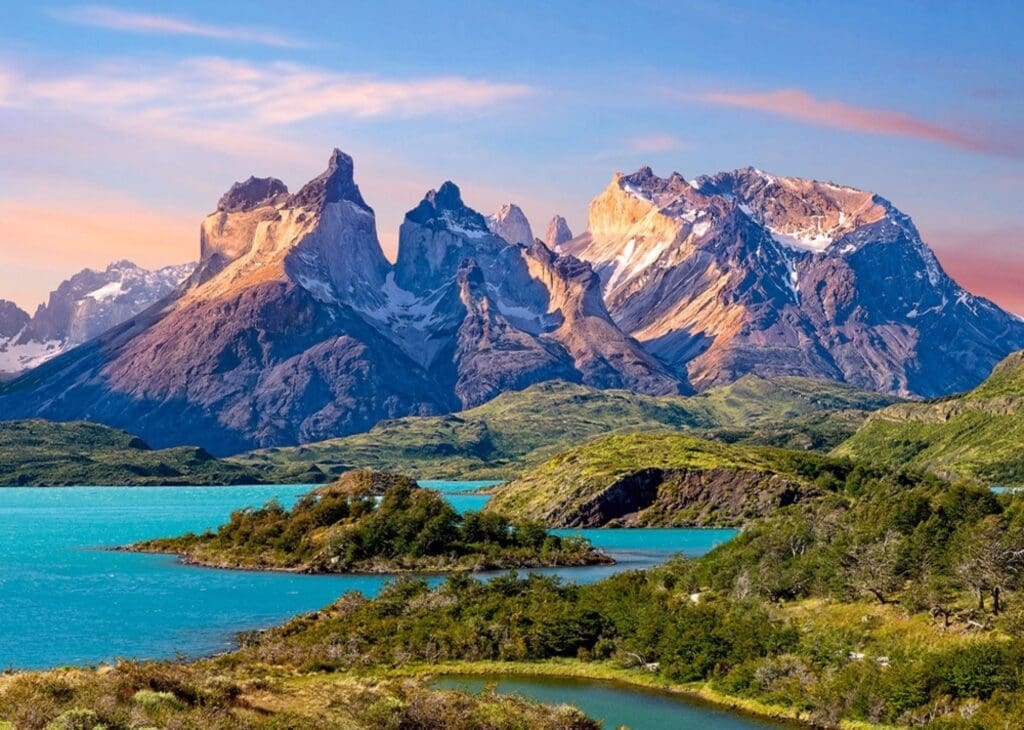

Table of Contents
- Patagonia: A Land of Remote Wonders and Alpine Challenges
- Discovering Torres del Paine: Gateway to South American Adventures
- Torres del Paine Argentina vs Chile: Contrasting Landscapes in Patagonia
- Scaling Fitz Roy: Challenges and Triumphs atop Patagonia’s Summit
- Patagonia’s Weather Patterns: An Alpinist’s Nemesis and Delight
- Picture-Perfect Scenic Views: Torres del Paine’s Iconic Granite Monoliths
- Trekking Through Patagonia: A Comparative Guide to National Parks
- Patagonia Tours Guide: Choosing the Ultimate Trekking Experience
- Accommodation in Patagonia: From Camping to Luxury Resorts
- Best Time to Visit Torres del Paine: Seasonal Insights for Travelers
- Embracing the Patagonian Way of Life: Travel Tales and Local Encounters
- Conclusion
- Source Links
Key Takeaways
- Discover the vast scale of Patagonia and the towering heights of Torres del Paine1.
- Evaluate the recent influx of luxury accommodations on the Chilean side1.
- Consider the diverse experiences offered by Torres del Paine Argentina vs Chile.
- Explore the advantages each country provides for travelers seeking the thrill of Patagonia.
- Understand how new resorts are transforming the Patagonian travel landscape1.
- Discover Argentina with VAMOS Academy. Your Premier Language School in Buenos Aires
Patagonia: A Land of Remote Wonders and Alpine Challenges
Stretching across the southern reaches of South America, Patagonia’s stunning expanse covers more than 400,000 square miles across Argentina and Chile, offering a rugged sanctuary for intrepid spirits seeking unparalleled adventure and scenic beauty2. An in-depth patagonia tours guide reveals a land where the majestic Andes mountains grant countless climbing walls, tempting those who dare to master its peaks with a promise of solitude, challenges, and untapped summits2.
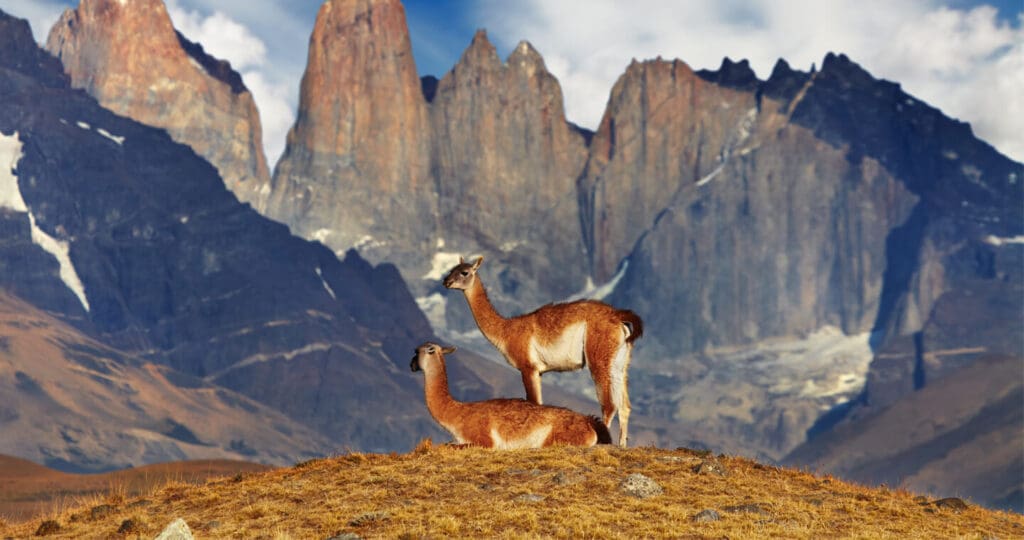

The Mystique of Patagonia’s Vast Wilderness
Amid the patagonia comparison, the vast wilderness of this region is a tapestry of chilean vs argentinean landscapes, each thread woven with the natural elements that defy the expectation of landscape exploration hiking enthusiasts2. In the heart of this untamed expanse, adventurers find themselves amidst extreme weather conditions—the howling winds, unexpected snowfall, and transient sunshine—forge not just the land, but the resolve of those who journey through it2.
Cultural and Historical Tapestry of Patagonia
Patagonia also serves as a canvas illustrating the rich narrative of humans interfacing with the sublime, reflecting centuries where Gondwana’s ancient inhabitants roamed and later, European explorers charted courses through the formidable landscapes. This profound patagonia comparison of cultural imprints turns every travel destination in the Andes into a multidimensional experience, where the echoes of history are as present as the physical summits that pierce the sky2.
Gondwana’s Ancient Inhabitants and European Exploration
The mosaic of Patagonia’s history is not just in its geography but in the testimonies of climbers who have pioneered routes, leaving behind stories of adventure travel tips imbued with their encounters with the unpredictable and short-lived climbing windows2. Opportunities for first ascents in Patagonia are as abundant as the tales of those who persevere, requiring adventurers to allot significant amounts of time to immerse themselves fully into the region’s challenging embrace2.
Each step taken in this majestic corner of the earth redefines south america travel destinations, as the region presents a persistent battle between sheer natural hostility and captivating charm—a balance that courses through the veins of tourism differences between countries. Indeed, points of interest for trekking in Patagonia are not just the physical peaks, but also the peaks of human spirit and determination required to ascend them2.
Discovering Torres del Paine: Gateway to South American Adventures
As a budding nexus for exploration, Torres del Paine National Park unveils the raw beauty and grandeur of Patagonia. The park’s spellbinding topography, sculpted by the hands of ancient glaciers, sets the stage for a patagonia trekking comparison that fascinates both seasoned hikers and casual visitors.
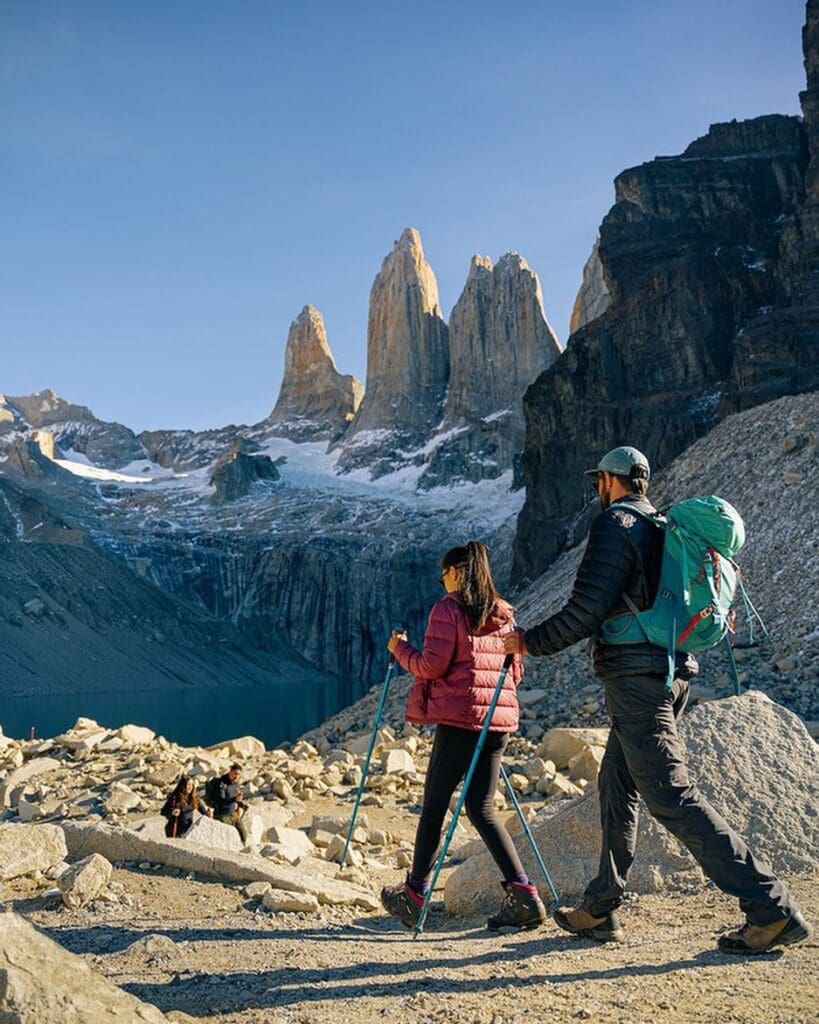

The National Park’s Formation and Glacial Influence
The formation of Torres del Paine National Park is a testament to nature’s power; glaciations have carved out a panorama of dramatic massifs, serene lagoons, and expansive ice fields. These formations highlight some of the best hikes in Torres del Paine, where each trail promises unparalleled glimpses into a world where ice and rock collide. The park’s present-day allure owes much to these frozen architects, with each glacial remnant marking a path through its storied past.
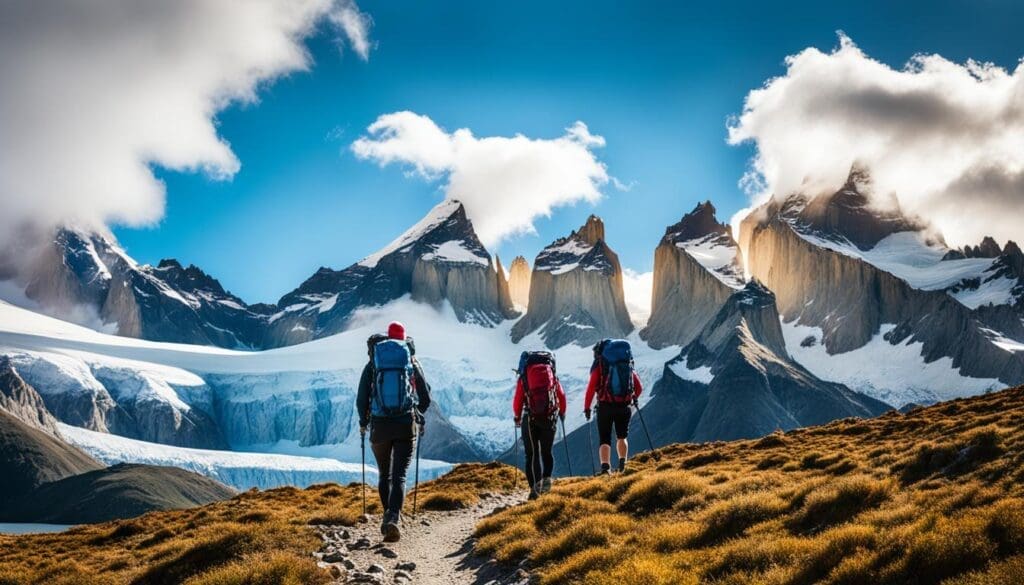

For trekking enthusiasts, this historical convergence of ice and rock presents a labyrinth of patagonia hiking trails. Each route serves as a living museum, showcasing the dynamic environmental processes that continue to shape the park’s landscapes. Keen explorers can unearth travel tips for Torres del Paine that both acknowledge the park’s glacial history and prepare them for its unique hiking experiences.
Traversing the Road ‘Ruta 40’ to Argentinean Patagonia
‘Ruta 40’ is more than just a route; it is an odyssey through the rugged backbone of Argentina, promising an adventure to those drawn towards the untamed spirit of Patagonia. Bridging urban centers to the tranquility of Torres del Paine, this storied highway offers an insightful narrative about Patagonia’s geology, wildlife, and culture. As the road ebbs and climbs through unfenced wilds and along the base of towering Andean peaks, travelers collect stories, camaraderie, and an inner stillness that only the road can deliver.
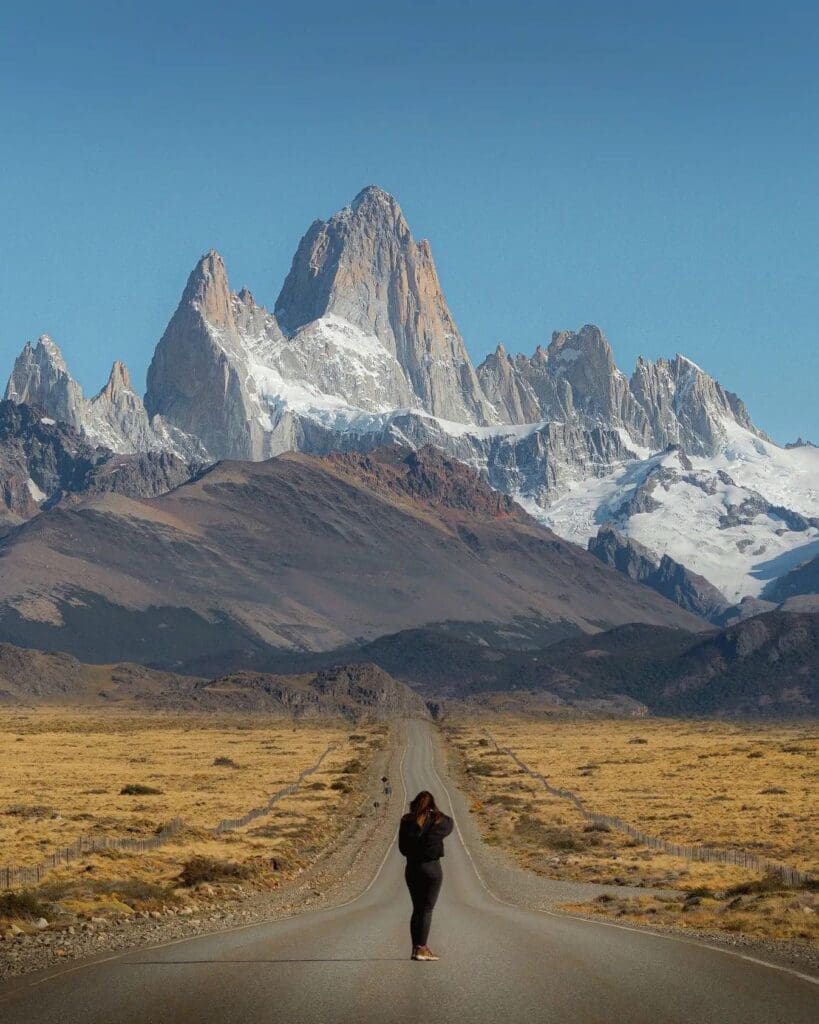

In conclusion, discovering Torres del Paine through its exquisite trails and the iconic ‘Ruta 40’ is to embark on a journey beyond the mere physical. It is an expedition that rewards the spirit with stories etched in the landscapes and an understanding of the forces that shaped them. This is the true essence of adventuring through South American Patagonia.
Torres del Paine Argentina vs Chile: Contrasting Landscapes in Patagonia
When delving into the torres del paine argentina vs chile debate, the conversation invariably turns to the distinctive and contrasting landscapes each country boasts within the famed Patagonian region. Chile’s pride, Torres del Paine National Park, spans a vast 181,414 hectares, enveloping visitors in a world where the iconic granite peaks of Torre d’Agostini, Torre Central, and Torre Monzino soar 2,500 meters into the cloud-draped skies3. Indeed, these mammoth structures are more than just geological wonders; they are symbols of nature’s enduring splendor, drawing an average of 252,000 annual visitors, over half of whom hail from foreign lands in search of adventure and the best hikes available3.
In contrast, the Argentine side of Patagonia, while not officially part of Torres del Paine, offers its own distinctive charms. Here, you find a kaleidoscope of scenic views encompassing rugged mountains, immense glaciers such as Perito Moreno, and far-reaching steppe-like plains. In the midst of economic challenges, evidenced by an estimated inflation rate of 200%, Argentina’s Patagonia remains an irresistible destination for serious hikers and landscape exploration hiking enthusiasts4.
The national park differences extend to their foundations and the varying ways they touch the spirit of each visitor. Established on May 13, 1959, and a UNESCO World Biosphere Reserve since 1978, Torres del Paine’s age-old geological formations tell stories of Cretaceous sedimentary rocks and Miocene-aged laccoliths, etched and sculpted by relentless glacial erosion processes3. This intricate geological dance has produced not only the towering peaks but a diverse hydrology system, complete with rivers, streams, and lakes like Grey Lake, Nordenskjöld Lake, and Lake Pehoé that originate from the Southern Patagonian Ice Field, providing points of interest for trekking that are rich in natural beauty and ecological importance3.
| Feature | Torres del Paine, Chile | Patagonia, Argentina |
|---|---|---|
| Peak Names | Torre d’Agostini, Torre Central, Torre Monzino | Fitz Roy, Cerro Torre |
| Major Glaciers | Glacier Grey, Pingo, Tyndall | Perito Moreno, Viedma |
| Unique Attractions | Paine Massif, French Valley | Ruta de los Siete Lagos, Valdés Peninsula |
| Annual Visitors | Approx. 252,000 | Varies by region |
| Ecosystem | Forest, lakes, glaciers | Mountains, steppe-like plains, coastal wildlife |
Key to the allure of this region are the opportunities for connection with nature’s raw power. In Chile, the temperate climate of cold rain sets the stage for the rainiest months, March and April, when trekkers can experience the park’s climate fully, undeterred by the monthly average rainfall of 80 mm3. Meanwhile, Argentine Patagonia promises unique wildlife encounters along the Ruta de los Siete Lagos or the Magellanic penguin colonies at Punta Tombo, each providing a profound narrative of the region’s biodiversity4.
Whether you are lured by the scenic vistas of Torres del Paine or the untamed wilderness of Argentina’s Patagonia, the exploration of these landscapes offers an unrivaled trekking experience. The national park differences, from their climates to their geological foundations, shape not only the physical contours of the region but also the memories and tales of those who have journeyed through their majestic terrain.
Scaling Fitz Roy: Challenges and Triumphs atop Patagonia’s Summit
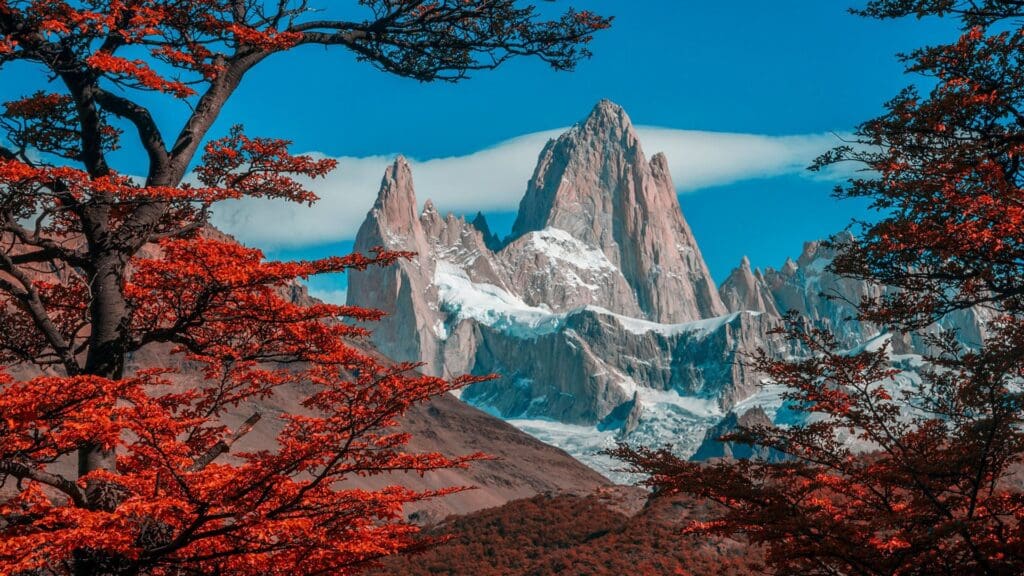

The sheer granite spires of Fitz Roy have become emblematic of the indomitable spirit of adventure synonymous with Patagonia. For mountaineers and trekkers alike, scaling Fitz Roy represents not just a physical challenge, but a foray into a mythic landscape that symbolizes the pinnacle of natural beauty and human perseverance.
The Allure of Fitz Roy’s Ascents
Known locally as Cerro Fitz Roy, this Patagonian marvel beckons climbers from all corners of the globe. The mountain’s unpredictable weather, technical climbs, and the sheer exhilaration of ascending its jagged peaks contribute to its allure. Scaling Fitz Roy is not merely a climb; it is a journey through some of the most spectacular hiking trails in Patagonia, culminating in a triumph that rewards the brave with unparalleled panoramic vistas.
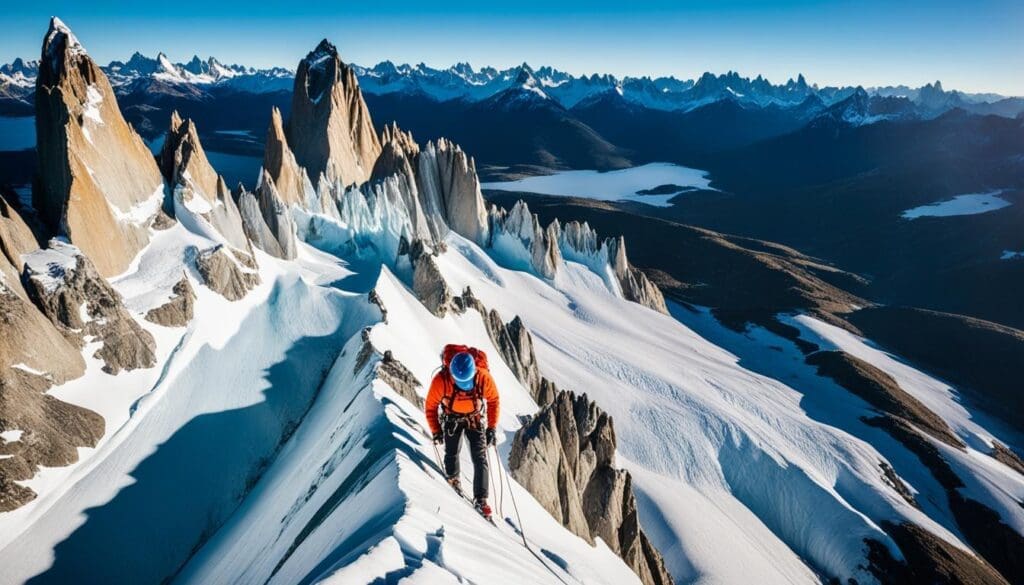

Hiking Trails and Climbing Ventures in Argentine Patagonia
While the ultimate goal for many is the summit of Fitz Roy, the region offers a web of trails suitable for various skill levels. From the novice hiker to the seasoned alpinist, each path affords a unique perspective of the mountain’s majesty. Below is a snapshot of the best routes aspiring adventurers might take:
| Trail Name | Difficulty | Duration | Scenic Highlights |
|---|---|---|---|
| Laguna de los Tres | Moderate | 8-10 hours (round trip) | Frontal view of Fitz Roy, Capri Lagoon, Fitz Roy River |
| Loma del Pliegue Tumbado | Hard | 8-9 hours (round trip) | 360-degree vistas, Ice Cap, Cerro Torre and Fitz Roy |
| Laguna Torre | Moderate | 6-7 hours (round trip) | Cerro Torre, glaciers, De Agostini base camp |
| Huemul Circuit | Extreme | 4-5 days (circuit) | Remote wilderness, South Ice Field, Viedma Glacier |
Argentine Patagonia’s challenging topography, varied climate, and incredible biodiversity solidify its reputation as being home to some of the best hikes in Patagonia. Every trail tells a story and every step taken on this sacred ground is a vow to the grandeur of nature—a testament to the amiable contest between humanity and earth, with Fitz Roy reigning as the ultimate arbiter.
Patagonia’s Weather Patterns: An Alpinist’s Nemesis and Delight
For alpinists and outdoor aficionados, the ever-shifting patagonia weather patterns are a pivotal aspect of their voyage. Recognizing the climatic whims often sets the stage for conversation at basecamps, and understanding them can mean the difference between triumph and an arduous retreat. The Torres del Paine, a marvel straddling Argentina and Chile, presents a theatrical stage where climatic forces act out in full splendor, adding a layer of complexity to the challenges alpinists face.
Predicting the Unpredictable: Weather Talks Among Alpinists
Weather talks among alpinists are not mere chit-chat; they are integral to strategizing successful ascents in Torres del Paine, where the weather can shift from serene to tempestuous without warning. Climbers frequently find themselves debating whether the mystifying skies will grant them a clear day or surprise them with swift and dramatic changes55. In this zone, weather pattern analysis reveals that alpinists may encounter anything from piercing sunlight to biting snow within a matter of hours5. The average wind speeds, hovering around 42 km/h, only magnify the unpredictability, encapsulating the essence of basecamp life in Patagonia5.
Basecamp Life: The Beauty of the Valle del Silencio
Within the heart of Patagonia lies the Valle del Silencio, an amphitheater of natural wonder that cradles the dreams of climbers seeking refuge from the weather’s caprices. Here, the climber’s resilience is tested by a range of conditions from sun-kissed dawns to chilled, hail-stricken dusks5. Adverse weather is a frequent visitor, impacting attempts to summit, yet also fostering a sense of camaraderie and shared experience amongst those who gather in this serene valley5.
The key to thriving amidst these weather patterns lies in the alpinists’ ability to adapt and their unyielding respect for nature’s raw power. A statistical analysis highlights not just the wide range of conditions one might face, but also the need to harvest insights from both Argentina and Chile’s experiences to fully prepare for an expedition into this climber’s paradise5.
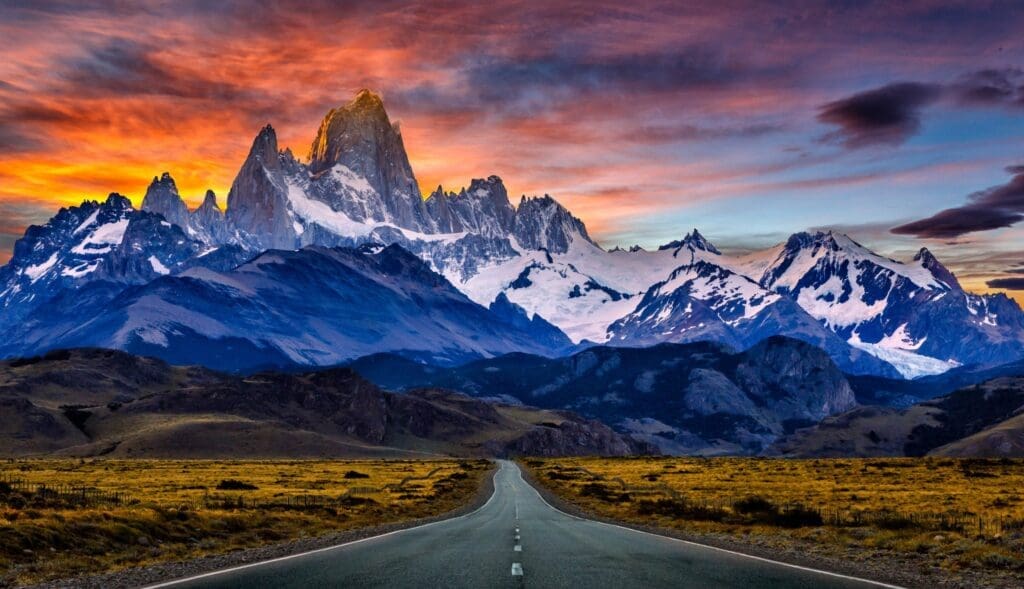

Picture-Perfect Scenic Views: Torres del Paine’s Iconic Granite Monoliths
Amidst the vast expanse of the Magallanes Region in Chilean Antarctica, Torres del Paine National Park stands as a testament to the awe-inspiring power of nature, covering an impressive 181,414 hectares of rugged terrain3. Visitors flock to this park not just for its adventurous trails but to immerse themselves in the scenic views offered by the dramatic patagonia landscape, where the striking Paine massif serves as the centerpiece of the park’s geography3.
Nestled at 51°0′0″S 73°0′0″W, Torres del Paine is a beacon for photographers and nature lovers alike3. The iconic granite monoliths – including the Cuernos del Paine and the three towers from which the park takes its name – are surrounded by a diverse hydrological network, featuring rivers like the Paine and numerous glacial lakes such as Dickson Lake, Nordenskjöld Lake, and Grey Lake, each more enchanting than the last3. Here, the scenic views culminate in a breathtaking panorama that encapsulates the essence of the patagonia landscape.
Despite its remote location, in 2019, Torres del Paine National Park welcomed a record-breaking 304,947 visitors, an indication of its growing popularity among both local hikers and international tourists3. The park’s glaciers – Grey, Pingo, and Tyndall – serve as icy sentinels preserving the purity of this uniquely Patagonian scene and are part of the majestic Southern Patagonia Ice Field3.
The park’s climate is characterized by temperate conditions with persistent cold rain, a factor that contributes to its lush, forested areas which cover about half of the region’s landmass3. This combination of abundant rainfall, particularly during the months of March and April, along with the park’s temperate days and cold nights, plays a crucial role in shaping Torres del Paine’s evergreen landscapes3.
As the windiest period blows through between November and January, the park transforms, showcasing the raw power of elemental forces on the patagonia landscape, sculpting out valleys like Valle del Francés and Valle del Silencio3. These valleys whisper the ancient secrets of the Cretaceous rocks and the Miocene laccolith that have seen the rise and retreat of glaciers, molding the landscape into its current form3. Traces of this geological dance are evident in the sedimentary history and glacial erosion that have given rise to Torres del Paine’s magnificent spires.
| Geographic Feature | Details |
|---|---|
| Glacial Lakes | Dickson, Nordenskjöld, Grey, and Sarmiento among others |
| Major Glaciers | Dickson, Grey, Zapata, and Tyndall from the Southern Patagonian Ice Field |
| Valleys | Valle del Francés, Valle Bader, Valle Ascencio, and Valle del Silencio |
| Forest Coverage | Protected forested areas covering approximately 51% of the region |
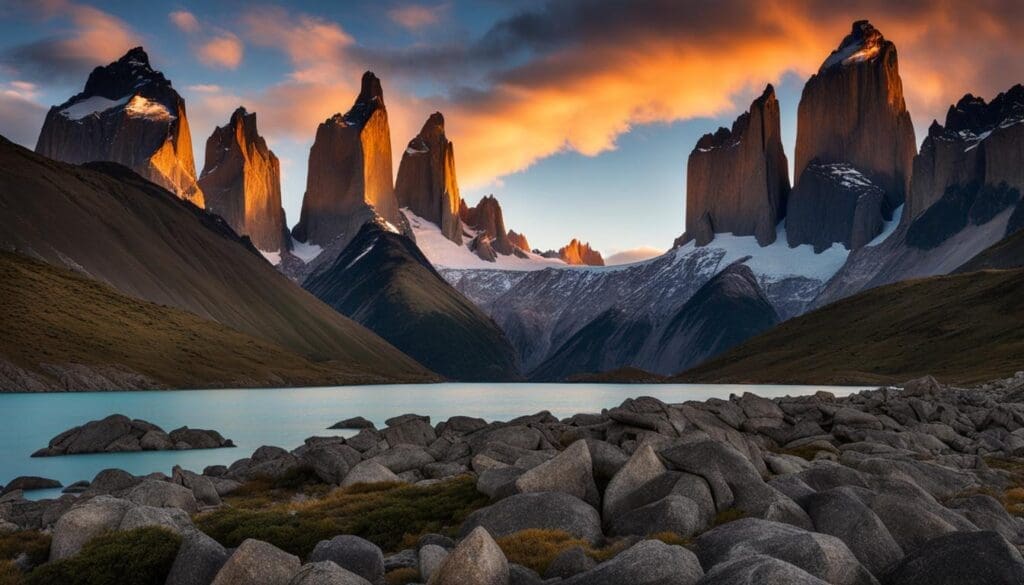

Amid the contemplation of this monumental torres del paine national park, visitors are reminded of their guardianship role; past tourist fires have scarred 150 km² in 1985, 155 km² in 2005, and a devastating 176 km² in the 2011/2012 season, calling upon all who tread its paths to preserve its majesty for generations to come3.
Resplendent in its beauty and rich in its ecological diversity, the iconic granite monoliths of Torres del Paine exemplify the convergence of geological wonder and the artistry of the natural world, presenting a canvas of scenic views that rival any painter’s masterpiece and symbolizing the enduring allure of the patagonia landscape3.
Trekking Through Patagonia: A Comparative Guide to National Parks
Embarking on a journey through the national parks of Patagonia is not simply a trek; it is an intimate dance with wilderness itself. Welcoming the bold and the adventurous, Patagonia stretches across Chile and Argentina, offering a myriad of trekking in South America opportunities that fuse the raw beauty of the landscapes with the thrill of exploration. As aficionados of the great outdoors compare the wildlife spotting opportunities and contemplate the best hikes, we immerse ourselves in an expansive guide tailored to elevate your adventure in the Andes.
Wildlife Spotting Opportunities in Chile vs Argentina
The duel between Chilean and Argentinian Patagonia does not rest solely upon the treks; it extends into the realms of biodiversity. In Chile, Torres del Paine National Park encompasses 448,280 acres of pristine terrain, home to pumas, Andean condors, and guanacos6. Argentine Patagonia spotlights its own cast of characters, with the national parks playing host to sightings of huemuls, Andean deer, and perhaps a stealthy glimpse of the elusive Patagonian puma.
Adventure Travel Tips: Best Hikes and Trekking Routes
For those seeking an original escapade, trekking in Patagonia offers routes that cater to the ambitions of every hiker. Covering 85 miles over eight to nine days, the O trek in Chilean Patagonia is a full circuit that congregates the indomitable spirits of the adventurous6. On the shorter side, the W trek spans 46 miles, inviting trekkers to a four to seven-day traverse of varied landscapes6. Let us not forget, the John Gardner Pass, boasting a climb of 3,940 feet over a 13.6-mile stretch, creates a perennial bond between the hiker and the ethereal Andean peaks6.
Armed with these insights, and considering how the water from the park’s sources is refreshingly drinkable with a hint of caution advised near human-touched streams6, one is well-equipped to forge a connection with the spirit of the wild, across the dreamlike terrains of the Andes and the ever-enigmatic Patagonia. Yet, through the caprices of Patagonia’s climate, bringing versatile gear from Rental Natales or engaging the guidance of teams like Chile Nativo could be the wisest companions for your trails6.
As a nod to environmental stewardship, the suggestion to carry a reusable water bottle resonates deeply, ensuring the preservation of these untamed treasures for generations of trekkers to come6. Let these adventure travel tips lead you to the heart of the national parks South America boasts, igniting a journey of breathtaking discovery among the travel destinations Andes has nurtured.
Patagonia Tours Guide: Choosing the Ultimate Trekking Experience
Embarking on a Patagonia trek is not merely about selecting a trail; it’s about immersing oneself in a realm of splendid isolation and rugged grandeur. An effective Patagonia tours guide must encompass the unique elements of both Argentinean and Chilean Patagonia to truly tailor the adventure to your desires.
Navigating Through Argentine and Chilean Patagonia
Understanding the nuances between chilean vs argentinean patagonia enriches your journey. The former dazzles with the majestic Torres del Paine National Park, renowned for its challenging circuit treks that call for keen planning and robust trekking equipment7. On the other hand, Argentine Patagonia beckons with iconic destinations like the Perito Moreno Glacier and the wilds of Tierra del Fuego, where flying between locations is a practical necessity due to the vast geographical spread7.
Travel Tips for Selecting the Right Patagonia Tour
For those contemplating Patagonia travel tips, timing and duration are essential. The optimal window for exploring both Argentine and Chilean Patagonia runs from December through mid-April, yet avoiding Argentina’s Patagonia in January may help elude the crowds7. Varying the trip’s length can also enhance the experience, with 5-9 days fitting for Argentine wonders and 7-10 days preferable for an in-depth Chilean adventure7.
Patagonia outdoor activities extend beyond trekking: Argentine Patagonia offers exquisite wildlife viewing and glacier excursions, whilst Chilean Patagonia is the quintessential destination for luxury lodging and picturesque road trips7. For a meaningful travel decision, consider these highlights:
| Argentine Patagonia Highlights | Chilean Patagonia Highlights |
|---|---|
| Perito Moreno Glacier | Torres del Paine |
| Peninsula Valdes (Whale-spotting Sep-Nov)7 | Carretera Austral |
| Tierra del Fuego, Ushuaia | Luxury Lodges |
| Bariloche | Multi-day Circuit Treks7 |
With passionate expertise, a travel guide Torres del Paine or tours through the frostbitten beauty of Perito Moreno can transform your Patagonia journey into a timeless memory.
When routing your odyssey through Patagonia, remember that each region offers distinct highlights and activities, a fact integral to crafting your personalized tour experience. Fly into Buenos Aires for Argentine scopes or Santiago de Chile to begin a Chilean voyage7. Include Los Glaciers National Park and its 13 major glaciers if your heart seeks the spectacular icy formations of Argentina, or chart a course for a multi-day exploration of Chile’s vaunted Carretera Austral to satisfy an urge for remote road tripping7.
So whether it’s trekking through Torres del Paine tours or indulging in the vitality of Patagonia’s outdoors, let this guide be the compass to your unparalleled adventure.
Accommodation in Patagonia: From Camping to Luxury Resorts
Finding the perfect place to stay while embracing the rugged beauty of Patagonia is essential for adventurers and leisure-seekers alike. Torres del Paine accommodations offer a range of options, from the thrill of camping under the stars to the indulgence of luxury resorts, letting you tailor your Patagonia outdoor activities to your comfort level.
Where to Stay: Torres del Paine Accommodations and Amenities
Visitors to Torres del Paine can select from numerous lodging options. With three main ways to approach your Patagonian escapade — flying into Puerto Natales, driving from Punta Arenas, or crossing the border by car or bus — the adventure begins well before arriving at the park8. Once there, synchronized with nature, you can camp at one of the nine campgrounds run by Vertice Patagonia and Las Torres Patagonia8, or opt for a more structured stay in hotels like Hotel Las Torres Patagonia or the exclusive Explora Patagonia Hotel Salto Chico8. The choices satisfy diverse budgets and preferences, ensuring everyone has access to the heart-stirring views and serene atmosphere that define the region8.
Adventurers keen on traversing the well-trodden paths can find solace in refugio accommodations scattered along the famous W Trek, a path that unveils 74 km of natural grandeur8. Those seeking solace off the beaten path can revel in the vivid hues of Pehoe Lake or participate in exhilarating kayaking trips on Grey Lake8.
Patagonia’s Remote Retreats: Experiencing the Great Outdoors with Comfort
Nestled in the remote corners of Patagonia are accommodations that harmonize luxury and the untamed outdoors. Top-tier options range from contemporary boutique lodgings in nearby Puerto Natales to exclusive resorts offering the full gamut of amenities89. Amidst the seclusion, EcoCamp Patagonia offers unique geodesic domes that fuse sustainability with comfort, particularly for those embarking on the extensive O Circuit trek10.
Committing to a multi-day trek requires meticulous planning, and securing your quarters in advance is a must, given the limited capacity and mandatory reservation system10. Whether you crave the rustic allure of a four-bed hostel dormitory or the opulent embrace of a 5-star hotel, the array of Torres del Paine accommodations ensures your Patagonia outdoor activities begin and end with a blend of adventure and luxury9.
Truly, whether you’re trekking under the colossal granite monoliths or simply soaking in the ethereal landscapes, your shelter in this untamed land will be just as memorable as the icy peaks and emerald waters that envelop you in Patagonia’s embrace.
Best Time to Visit Torres del Paine: Seasonal Insights for Travelers
Deciding on the best time to visit Torres del Paine is a critical step in planning your journey to one of South America’s most majestic national parks. As you travel to South America, understanding Patagonia’s climatic patterns can enhance your experience by allowing you to fully immerse yourself in the remarkable landscapes and activities available during different seasons.
Travel to South America: Planning Around Patagonia’s Seasons
Spring in Torres del Paine offers a pleasant climate for hikers, with average temperatures fluctuating from lows in the 30s to highs in the 60s Fahrenheit, providing an invigorating setting for outdoor enthusiasts11. On the other hand, those preferring warmer weather may choose to visit in summer when rainfall averages between 2.36-2.95 inches, creating lush, verdant scenes perfect for photography and exploration11.
Off-Peak Adventures: Benefits of Visiting During Shoulder Seasons
Fall visits are characterized by ample daylight with 11 hours in April, dwindling to 9 in May, making this period ideal for travelers looking for longer days to indulge in all that Patagonia has to offer11. Winter, while cooler with lows in the 20s and highs only reaching the low 40s Fahrenheit, can still be enchanting for those seeking solitude and stunning wintry landscapes, especially when benefitting from 8 hours of daylight in June and July, and 10 in August11.
Visiting during these off-peak seasons not only affords you with less crowded trails but also can offer a distinct perspective of the park’s beauty, as the changing foliage and snow-capped peaks present a completely different backdrop, enriching the travel tips for Torres del Paine you’ve carefully curated.
| Season | Average Temperature (°F) | Average Rainfall (inches) | Hours of Daylight |
|---|---|---|---|
| Spring | 30s – 60s | – | – |
| Summer | – | 2.36 – 2.95 | – |
| Fall | – | – | 9 – 11 |
| Winter | 20s – low 40s | – | 8 – 10 |
Finding the best time to visit Patagonia depends on personal preferences and the kind of experience you’re seeking. Whether you’re an avid trekker yearning for the challenge of cold-weather hikes or a nature lover in pursuit of tranquil beauty and milder temperatures, Torres del Paine welcomes you with open arms year-round.
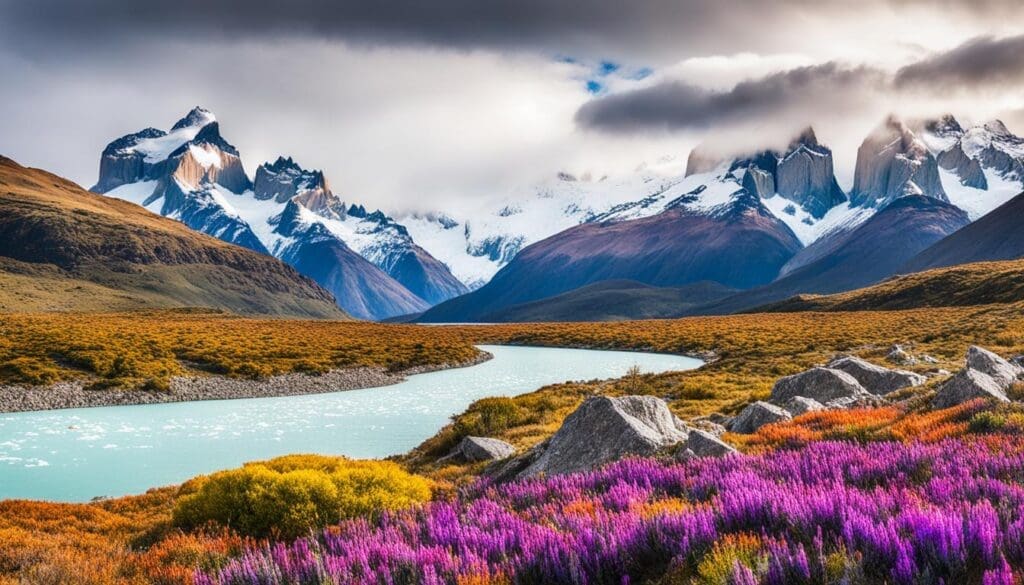

Embracing the Patagonian Way of Life: Travel Tales and Local Encounters
The allure of Patagonia, with its sprawling ice fields and majestic mountains, beckons the adventurous spirit in travelers seeking to immerse themselves in the region’s awe-inspiring beauty. In the town of Carlos Pellegrini, a new narrative emerges, reflecting a poignant transition from hunting to ecotourism, wherein residents have become stewards of the land as park rangers or staff at Parque Iberá’s Interpretation Center12. Meanwhile, local enterprises like Vira Vira offer a profound connection with the Mapuche indigenous population and actively support the wellbeing of surrounding communities, showing an example of the “Care of the People” through local initiatives such as a sponsored rainwater collection system in Quelhue12. These narratives, woven into the fabric of daily life, exemplify the essence of embracing the Patagonian way of life.
While the region is known for its incredible vistas, challenges such as irresponsible tourism practices pose a risk to the delicate balance of nature and community in Torres del Paine National Park. It brings to light the commendable efforts by entities like Estancia Cerro Guido to foster a sustainable coexistence of livestock and wildlife through initiatives that include puma research and shepherd dog programs12. Understanding local culture extends beyond simple interaction; it also means supporting and contributing to the conservation efforts that make this way of life possible.
Stories from Vamos Academy: Learning Spanish in Buenos Aires
Immersing oneself in local culture begins with the language, and this is where travel tales from Vamos Academy come alive. Students from around the globe share stories about understanding local culture, heralding the transformative experience of learning Spanish in Buenos Aires. The language opens doors to authentic encounters and enables deeper connections with the people who call this vibrant city and the expansive Patagonian plains home.
Understanding Local Culture: Interaction with Patagonia’s Residents
Local encounters are the essence of any genuine travel experience. They are moments where one can appreciate the gentle pace of life and the age-old traditions that define the spirit of a place. In Patagonia, travelers can truly connect with this spirit by engaging with projects that protect the wildlife and support the livelihoods of residents, such as those introduced by Estancia Cerro Guido12. Tourism, when done responsibly, serves as a bridge between cultures and an opportunity for mutual growth. It is through such encounters that one can fully appreciate the call to tread lightly and embrace the Patagonian way of life.
Conclusion
Embarking on a journey through Torres del Paine is an encounter with the raw beauty and vast expanse of Patagonia, a region where the forces of nature and history have intertwined. The Magallanes y Antártica Chilena region not only commemorates half a millennium since Magellan’s historic discovery but also showcases the awe-inspiring glacial realms of Chile, which claims an impressive array of over 24,000 glaciers, including the mighty Campos de Hielo Norte and Campos de Hielo Sur, acknowledged as the third largest icefields in the world13. The multifaceted landscapes of Argentina and Chile provide trekkers with both the imposing John Gardner Pass and the iconic towers’ base viewpoint, where the Torres del Paine National Park spans across an impressive 1,814km214.
The intricate dance of sovereignty over the glaciers, which hold crucial freshwater resources and support the surrounding ecosystems, continues to be a delicate subject, with approximately 1,000 km2 of land still undefined between Chile and Argentina13. The pursuit of resolving these territorial nuances is bolstered by the understanding that these natural structures are not just geographical claims but are fundamental to the sustainability of life in the region. Paths like the Paine Circuit, inviting adventurers for an 8-night trek with the reward of less trodden trails and unmatched vistas in the northern part of the park, beckon those seeking solitude amidst nature’s grandeur14.
A visit to Torres del Paine can be optimized by considering the Patagonian seasons, where each period presents a unique palette of experiences, from the vernal whispers of spring to the quiet solitude of the winter snowscapes15. Adventurers and contemplators alike can find their perfect moment under the Southern Cross, scaling the summit of outdoor challenges, selecting soul-stirring tours, and immersing themselves in the authentic Patagonian way of life. Truly, Torres del Paine and its encapsulating region offer much more than just a breathtaking backdrop; they offer a canvas for a transformative adventure, leaving an indelible mark on all who traverse its terrain.
Source Links
- https://www.nytimes.com/2013/01/06/travel/chilean-patagonias-peaks-up-close.html
- https://www.nationalgeographic.com/adventure/article/patagonia-chile-argentina-climbers-paradise
- https://en.wikipedia.org/wiki/Torres_del_Paine_National_Park
- https://worldlyadventurer.com/highlights-where-to-go-in-patagonia/
- https://www.gutenberg.org/files/3201/files/COMMON.TXT
- https://www.afar.com/magazine/what-you-need-to-know-before-hiking-torres-del-paine-patagonia
- https://www.kimkim.com/c/chilean-patagonia-vs-argentine-patagonia-which-is-right-for-you
- https://www.reneeroaming.com/guide-to-exploring-torres-del-paine-national-park-patagonia/
- https://www.thetravel.com/where-to-stay-in-patagonia/
- https://www.travelandleisure.com/trip-ideas/nature-travel/torres-del-paine-patagonia-trek
- https://www.cascada.travel/blog/when-is-the-best-time-to-visit-torres-del-paine
- https://www.cntraveler.com/story/how-argentina-and-chiles-rewilded-areas-are-ushering-in-a-new-era-of-eco-travel
- https://www.glaciareschilenos.org/en/report/chile-and-argentina-a-historical-conflict-in-campos-de-hielo-sur/
- https://www.cascada.travel/blog/hiking-the-paine-circuit-full-guide
- https://www.kimkim.com/c/best-time-to-visit-patagonia



